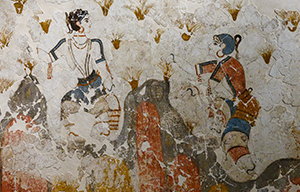The creative collaboration between AUEB and Diazoma bears fruit
Project Lavrio year 2023-2024. Completion of the innovative action “Education, Entrepreneurship and Culture” for the academic year 2023-2024 between the Teacher Education Program of AUEB, the Association “Diazoma” and the collaborating bodies
Elafonisos Eco Week; 10 – 16 June 2024
Spring Rites and the Crocus Collectors of Thera
Demolition of the Expropriated Buildings on the Site of the Ancient Theatre of Acharnes Commences
Source; Θέματα Αρχαιολογίας
Volume 7, Issue 1 January – August 2023 [pp. 6-15]
The celebrations of the coming of Spring, this seasonal «mystery» with enormous radiance, were the reason for people to gather, to praise nature, to honor the gods who brought new life to the world. The celebrations included rituals of new beginnings after the dark winter, rituals of joy, renewal, rebirth and hope for a better future. The myth of the abduction of the goddess of vegetation is prehellenic. The importance, the symbolism of crocus and as an important element of blooming nature in spring is reinforced by the fact that it is included among the basic flowers collected by Kori-Persephone (nymph of vegetation) with her companions in the tender meadow of the Nysion field shortly before her abduction by the male deity of the underworld for marriage. Among the three «saffron gatherers» of the famous fresco of Santorini, who collect the flowers, the most mature with the basket is recognized as the priestess of the goddess seated on a high throne, the second young saffron gatherer is considered an apprentice collector, with her skull sheared according to the Minoan custom of passing from the age of the virgin to that of the class of women on the verge of marriage. The third young saffron gatherer empties the yolks from her basket into a wide canister in front of the throne of the Mistress of the Animals. This scene of the saffron gathering by young virgins and the offering to the goddess is a scene of initiation ritual, passage to the age of marriage. The rite of collecting flowers by young women in spring in the presence of the great goddess of nature, such as Demeter and mistress of the Animals, is a symbolic act that represents the renewal of life, a way for young women to connect with cultural and religious traditions, to express their love and respect for the natural world and the «mystery» of life, of death and rebirth, participating in the rite of Spring and the custom of passing to the age of marriage, related to the rite of descent and ascent of the Maiden, of Kore. The initiation ceremonies of young girls into sanctuaries of Artemis were part of religious and cultural tradition. The girls participated in cleansing rituals by living in a special place in the sanctuary. They offered flowers, fruits, and symbolic objects, such as toys and clothing, and performed symbolic acts representing the transition from childhood to that of a woman, such as cutting a lock of hair, cutting part of the skull and participating in torch races and dances; they also made vows, pledging loyalty and devotion to the deity, pledges to celibacy and service in the sanctuary for a period of time, learning myths and traditions related to the goddess’s activities.
Key words: Spring, Crocus collectors, Ritual, Initiation, Thera
COPYRIGHT: © Themes in Archaeology, 2023 – ISSN 2653-9292
Author for correspondence: –
The original article is in the Library of the Themes in Archeology
